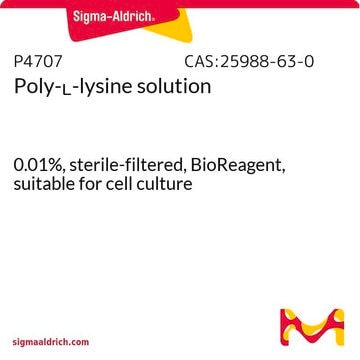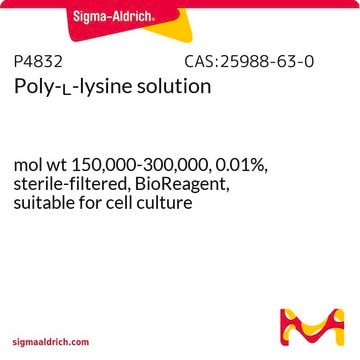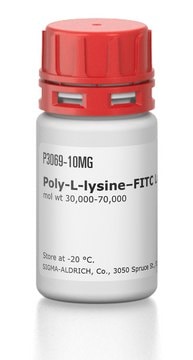P9155
Poly-ʟ-Lysine Hydrobromide
synthetic, mol wt 30,000-70,000, powder, γ-irradiated, suitable for cell culture, BioXtra
Sinónimos:
PDL HBr
About This Item
Productos recomendados
Nombre del producto
Poli-L-lisina hydrobromide, mol wt 30,000-70,000, lyophilized powder, γ-irradiated, BioXtra, suitable for cell culture
origen biológico
synthetic (organic)
Nivel de calidad
esterilidad
γ-irradiated
Línea del producto
BioXtra
Formulario
lyophilized powder
mol peso
30,000-70,000
envase
pkg of 5 mg
técnicas
cell culture | mammalian: suitable
cobertura de la superficie
4 μg/cm2
solubilidad
H2O: soluble 50 mg/mL, clear, colorless
Condiciones de envío
ambient
temp. de almacenamiento
−20°C
cadena SMILES
Cl.NCCCCC(N)C(O)=O
InChI
1S/C18H38N6O4/c19-10-4-1-7-13(22)16(25)23-14(8-2-5-11-20)17(26)24-15(18(27)28)9-3-6-12-21/h13-15H,1-12,19-22H2,(H,23,25)(H,24,26)(H,27,28)/t13-,14-,15-/m0/s1
Clave InChI
WBSCNDJQPKSPII-KKUMJFAQSA-N
¿Está buscando productos similares? Visita Guía de comparación de productos
Descripción general
Aplicación
Poly-L-lysine hydrobromide has been used to adhere the dissociated cells of cortical tissues into the culture plates. It has also been used to treat slides, to fix samples on it for immunohistochemical analysis.
Acciones bioquímicas o fisiológicas
Componentes
Precaución
Nota de análisis
Otras notas
Código de clase de almacenamiento
11 - Combustible Solids
Clase de riesgo para el agua (WGK)
WGK 3
Punto de inflamabilidad (°F)
Not applicable
Punto de inflamabilidad (°C)
Not applicable
Equipo de protección personal
Eyeshields, Gloves, type N95 (US)
Elija entre una de las versiones más recientes:
Certificados de análisis (COA)
¿No ve la versión correcta?
Si necesita una versión concreta, puede buscar un certificado específico por el número de lote.
¿Ya tiene este producto?
Encuentre la documentación para los productos que ha comprado recientemente en la Biblioteca de documentos.
Los clientes también vieron
Artículos
Poly-Lysine enhances cell binding with positively-charged surface ions, optimizing electrostatic interaction on culture surfaces for increased cell attachment.
Poly-Lysine enhances cell binding with positively-charged surface ions, optimizing electrostatic interaction on culture surfaces for increased cell attachment.
Poly-Lysine enhances cell binding with positively-charged surface ions, optimizing electrostatic interaction on culture surfaces for increased cell attachment.
Poly-Lysine enhances cell binding with positively-charged surface ions, optimizing electrostatic interaction on culture surfaces for increased cell attachment.
Protocolos
Adhere cells to solid substrates using poly-lysine, which enhances electrostatic interaction between negatively charged ions of the cell membrane and the culture surface.
Nuestro equipo de científicos tiene experiencia en todas las áreas de investigación: Ciencias de la vida, Ciencia de los materiales, Síntesis química, Cromatografía, Analítica y muchas otras.
Póngase en contacto con el Servicio técnico








